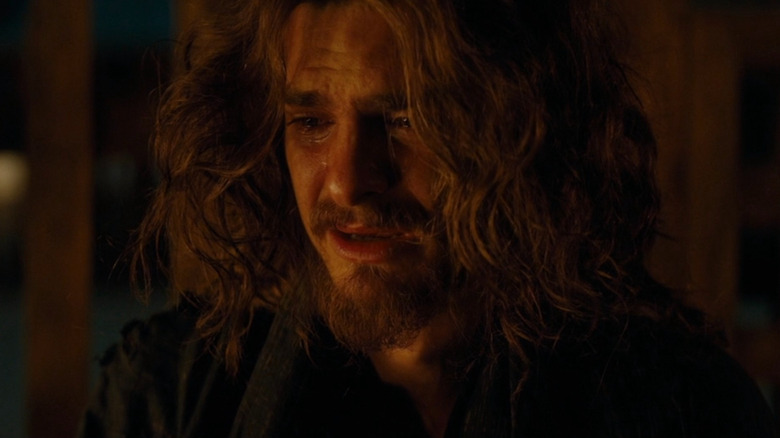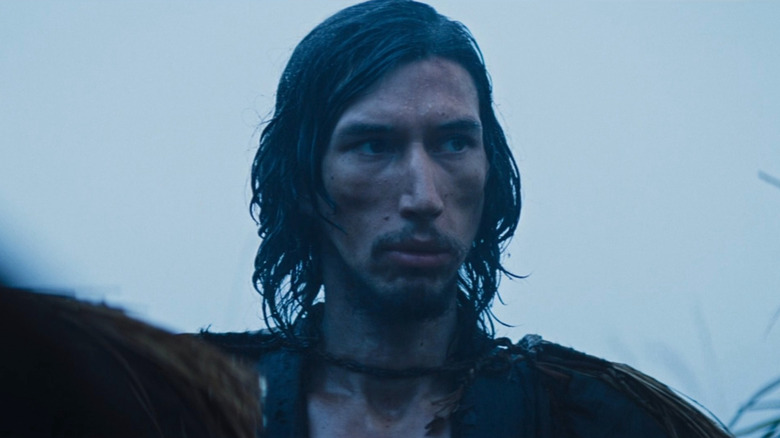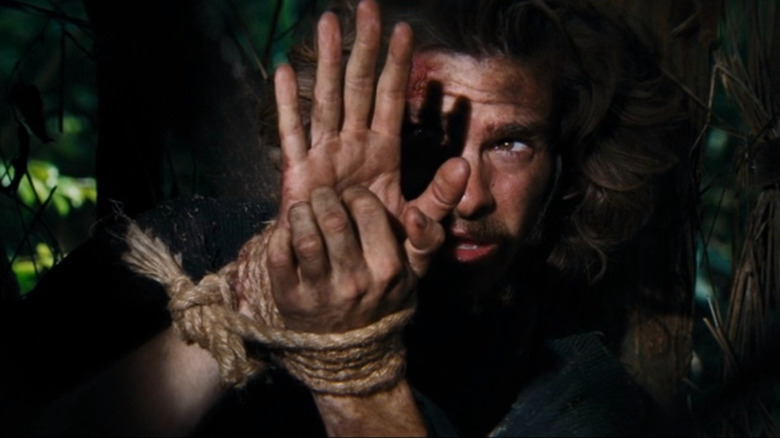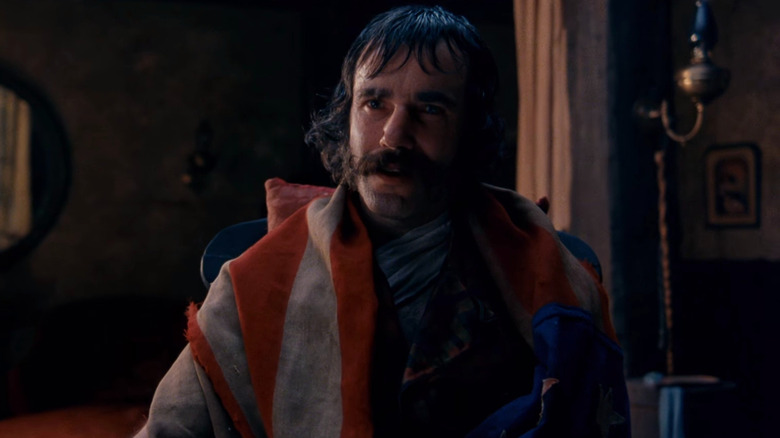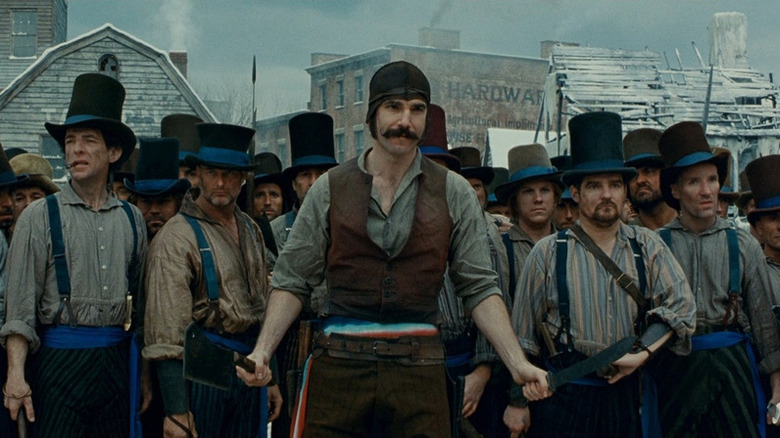Martin Scorsese's Passion Project Took Almost 30 Years To Get Made
Despite no one in my family being Catholic, I ended up attending a Catholic high school. As far as Catholic schools go, it was fairly lax. No strict uniforms, no nuns skulking the hallways, and they didn't try hard to convert me. I ended up having a better relationship with one of my religion teachers than I did with many of the students, as she was one of few people there with any interest in art. I remember how excited we were with the announcement of Martin Scorsese's "Silence," adapted from the historical fiction novel by Japanese author Shūsaku Endō (which she would assign us to read). Scorsese was riding high off of his Oscar win for "The Departed" a few years earlier, and the cast was to die for: Daniel Day-Lewis, Benicio Del Toro, Gael García Bernal.
It would take another seven-and-a-half years before "Silence" hit the big screen. The previously announced trio of actors was replaced with Andrew Garfield, Adam Driver, and Liam Neeson. I was no longer a student, having graduated from college a year earlier. I lost touch with my former religion teacher. I could not believe it was actually happening. But it arrived! I sat down in a theater and watched it, and thankfully, all that time was not for naught. "Silence" blew me away. It was a harrowing, gorgeous look at the egoism of martyrdom, and I reached out to my teacher to tell her how great it was.
It depressed me how much of shrug the movie was received with, infamously tanking at the box office. I thought seven-and-a-half years was a long time to wait for "Silence." Martin Scorsese sat with the material much longer. He had been trying to make the film for nearly 30 years. Scorsese seems like the kind of person who values artistic success more than financial ones, in which case I hope he is thrilled as I am with how his decades-long passion project turned out. But how did it take Scorsese, one of our most venerated filmmakers, this long to get "Silence" on screen?
Getting it right on the page
Martin Scorsese was first given the book "Silence" in 1988, the same year his film "The Last Temptation of Christ" was released. While that film is beloved today, it was marred by the religious right upon release, as is any art that deviates from the "agreed upon" interpretations of Christianity. But it had its fans, and one was Episcopalian Bishop Paul Moore. He gave Scorsese the book "Silence," and Scorsese was immediately struck by it. However, he didn't see how he would make it into a movie right away. In a press conference for the film [via Den of Geek], Scorsese said, "I found it went deeper, and that is where I wanted to go, but I didn't know how to go there."
In another press conference, he talked about the script development, which took quite a while:
"We made a first attempt at a script in about '91 or '92, and we didn't feel that was so successful ... It took another 15 years before we were able to, myself and my co-writer [Jay Cocks], develop a script we thought was the right way to go with the book."
Filmmakers often have a number of plates spinning, launching into whatever they are able to make at the time, but 15 years on a script is highly unusual. He made incredible movies like "The Age of Innocence" and "Gangs of New York" in the meantime. The 15-year mark would put it right around the time of "The Departed," and after winning Best Picture and Best Director, it looked like it was finally going to happen. That's when the casting announcements started coming out.
Then it all fell apart, as a film about 17th century Portuguese missionaries in Japan was a tough sell for any studio, and he ended up pivoting to the pulpy psychological horror movie "Shutter Island." Emma Tillinger Koskoff, who worked as an assistant for Scorsese on "The Aviator" and as a producer on all his films since, said in a Hollywood Reporter roundtable, "Every movie that was next was always 'Silence.'"
Finally getting Silence off the ground
"Shutter Island" was the first in a string of films Martin Scorsese made for Paramount. The film made almost $300 million at the box office. His follow-up, "Hugo," did not light up the box office but garnered a whopping 11 Academy Award nominations and won five. Two years later came "The Wolf of Wall Street." The film satisfied both camps, raking in nearly $400 million and scoring five Oscar noms. Scorsese and Paramount were on a bit of a run. So after the triptych, Scorsese and company were able to convince Paramount to let him make "Silence."
Still, Paramount put limitations on the film. At $46 million, this was Scorsese' least expensive film since 1999's "Bringing Out the Dead." He had been hovering around the $100 million budget zone for over a decade, and scaling back requires creative and time restraints. Plus, they were shooting in the middle of Taiwan, often hours from the nearest town, in weather that could change on a dime. As Emma Tillinger Koskoff put it:
"We were under great financial pressure, schedule pressure. We didn't have the luxury of, you know, calling back home and being like, 'Sorry, we're five days behind. We need some more dough.' It's not happening. So he and I really worked, for the first time, as closely as we ever have, and we were both so committed to making this movie ... He really listened to me, and I just tried to keep him focused, problem-solving left and right, keeping Marty feeling safe, and not distracted by, you know, having to reshoot and making the day and somehow figuring it out."
Scorsese finally got his passion project made. And it flopped. It was an artistic success, but it made no money. That is a big reason why he had to head to Netflix to make "The Irishman" and Apple to make "Killers of the Flower Moon." Studios don't see his stuff as theatrically viable anymore, which is a shame considering his stature. But he got to make "Silence," and we should be grateful.
Not the only film that took decades
"Silence" is not Martin Scorsese's only film that took decades to get to the screen. Another long-hauler was his 2002 period gangster epic "Gangs of New York." The 1860s-set picture starring Leonardo DiCaprio, Daniel Day-Lewis, and Cameron Diaz took almost exactly 33 years from when Scorsese first read Herbert Asbury's book of the same name to it being released in theaters in December 2002.
According to the film's audio commentary, Scorsese first encountered Asbury's book on January 1, 1970 when he saw it on someone's bookshelf and started reading it. He brought the book to his "Silence" co-writer, Jay Cocks, not too long after. A couple years later they started working on a screenplay. Scorsese faced the usual challenge to get it made: money. "Gangs of New York" is an epic, and it required basically reconstructing a city from a century ago. In the 1970s, he was making successful but low budget pictures. His one shot on a bigger scale, "New York, New York," completely tanked. His original plan was to make "Gangs of New York" at the end of the '70s, but as Scorsese said, "The system changed. Hollywood changed." The New Hollywood director-driven era was over.
He needed a string of hits to get the money back on his side, and in the 1990s, he had "Goodfellas," "Cape Fear," and "Casino." In 1999, making the film was in serious talks again, and they had another ace: Leonardo DiCaprio. He was fresh off of "Titanic," the biggest movie of all time. Harvey Weinstein and Miramax, always looking for respectability, agreed to put up the money.
Let the man make what he wants to make
"Gangs of New York" was supposed to be released at the end of 2001. Then Weinstein and Scorsese got into a battle over the film's length in post production, which halted the release for a full year. But it did come out, and unlike "Silence," it was an unqualified success, grossing nearly $200 million and scoring 10 Oscar nominations (though stupidly it didn't win any, particularly for Day-Lewis' performance).
It should be so much easier for Scorsese to make the movies he wants to. While it wasn't a 30-year battle like these movies, "The Irishman" took over a decade before someone agreed to make it. "The Last Temptation of Christ" also took over a decade. Look ... he's Martin Scorsese. He makes the best films. Especially now at 79 years old, let him make what he wants to make. Do you want to be the person that lets a Scorsese passion project disappear into the ether forever? It's cinematic malpractice.
